A Comprehensive Analysis of Value-Based Health Care System Reform
VerifiedAdded on 2023/06/03
|19
|4708
|254
Report
AI Summary
This report provides a comprehensive analysis of a value-based health care system, highlighting its importance and the principles guiding its establishment, including quality, inclusiveness, sustainable funding, and equity. It emphasizes the need for coordination between the Commonwealth Government, states, and territories to address health issues effectively. The report also acknowledges the health disparities faced by marginalized groups and advocates for improving their living and working conditions. Furthermore, it discusses the demand and elasticity of demand for health care services, particularly among individuals with chronic conditions and the aging population. Ultimately, the report champions the adoption of a value-based health care approach in Australia, emphasizing the balance between costs and benefits to ensure healthier individuals and a more efficient health care system. Desklib offers similar solved assignments and resources for students.
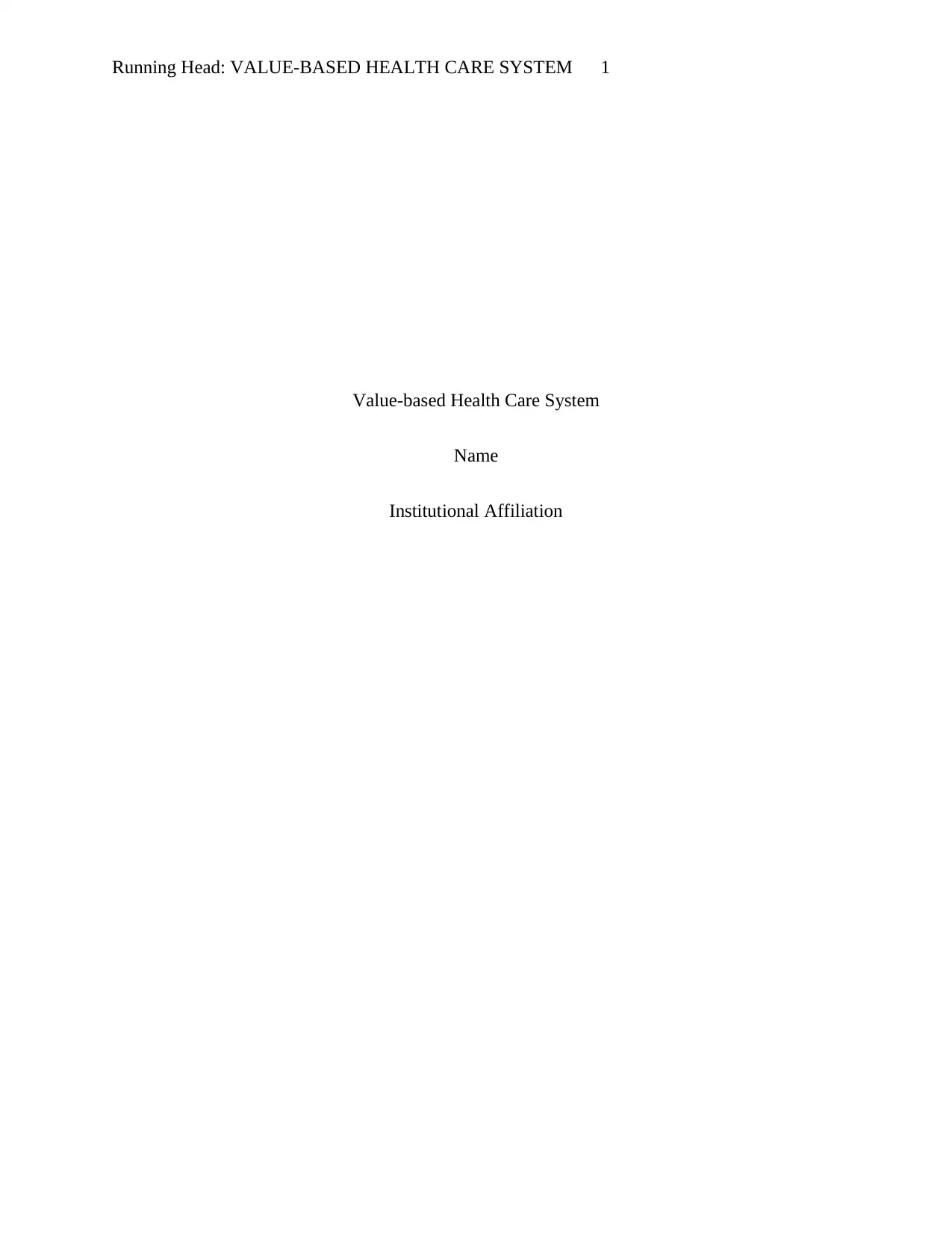
Running Head: VALUE-BASED HEALTH CARE SYSTEM 1
Value-based Health Care System
Name
Institutional Affiliation
Value-based Health Care System
Name
Institutional Affiliation
Paraphrase This Document
Need a fresh take? Get an instant paraphrase of this document with our AI Paraphraser
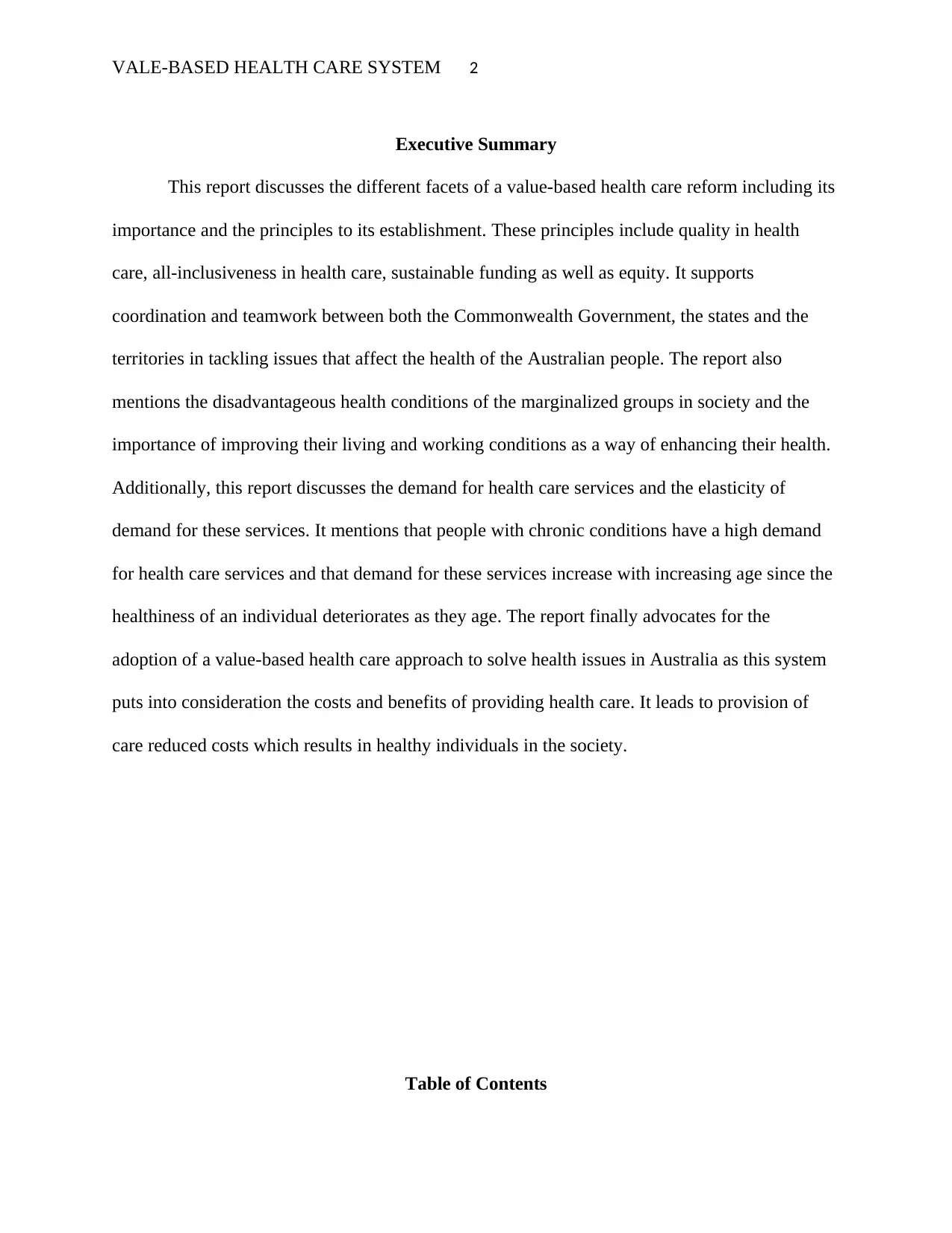
VALE-BASED HEALTH CARE SYSTEM 2
Executive Summary
This report discusses the different facets of a value-based health care reform including its
importance and the principles to its establishment. These principles include quality in health
care, all-inclusiveness in health care, sustainable funding as well as equity. It supports
coordination and teamwork between both the Commonwealth Government, the states and the
territories in tackling issues that affect the health of the Australian people. The report also
mentions the disadvantageous health conditions of the marginalized groups in society and the
importance of improving their living and working conditions as a way of enhancing their health.
Additionally, this report discusses the demand for health care services and the elasticity of
demand for these services. It mentions that people with chronic conditions have a high demand
for health care services and that demand for these services increase with increasing age since the
healthiness of an individual deteriorates as they age. The report finally advocates for the
adoption of a value-based health care approach to solve health issues in Australia as this system
puts into consideration the costs and benefits of providing health care. It leads to provision of
care reduced costs which results in healthy individuals in the society.
Table of Contents
Executive Summary
This report discusses the different facets of a value-based health care reform including its
importance and the principles to its establishment. These principles include quality in health
care, all-inclusiveness in health care, sustainable funding as well as equity. It supports
coordination and teamwork between both the Commonwealth Government, the states and the
territories in tackling issues that affect the health of the Australian people. The report also
mentions the disadvantageous health conditions of the marginalized groups in society and the
importance of improving their living and working conditions as a way of enhancing their health.
Additionally, this report discusses the demand for health care services and the elasticity of
demand for these services. It mentions that people with chronic conditions have a high demand
for health care services and that demand for these services increase with increasing age since the
healthiness of an individual deteriorates as they age. The report finally advocates for the
adoption of a value-based health care approach to solve health issues in Australia as this system
puts into consideration the costs and benefits of providing health care. It leads to provision of
care reduced costs which results in healthy individuals in the society.
Table of Contents
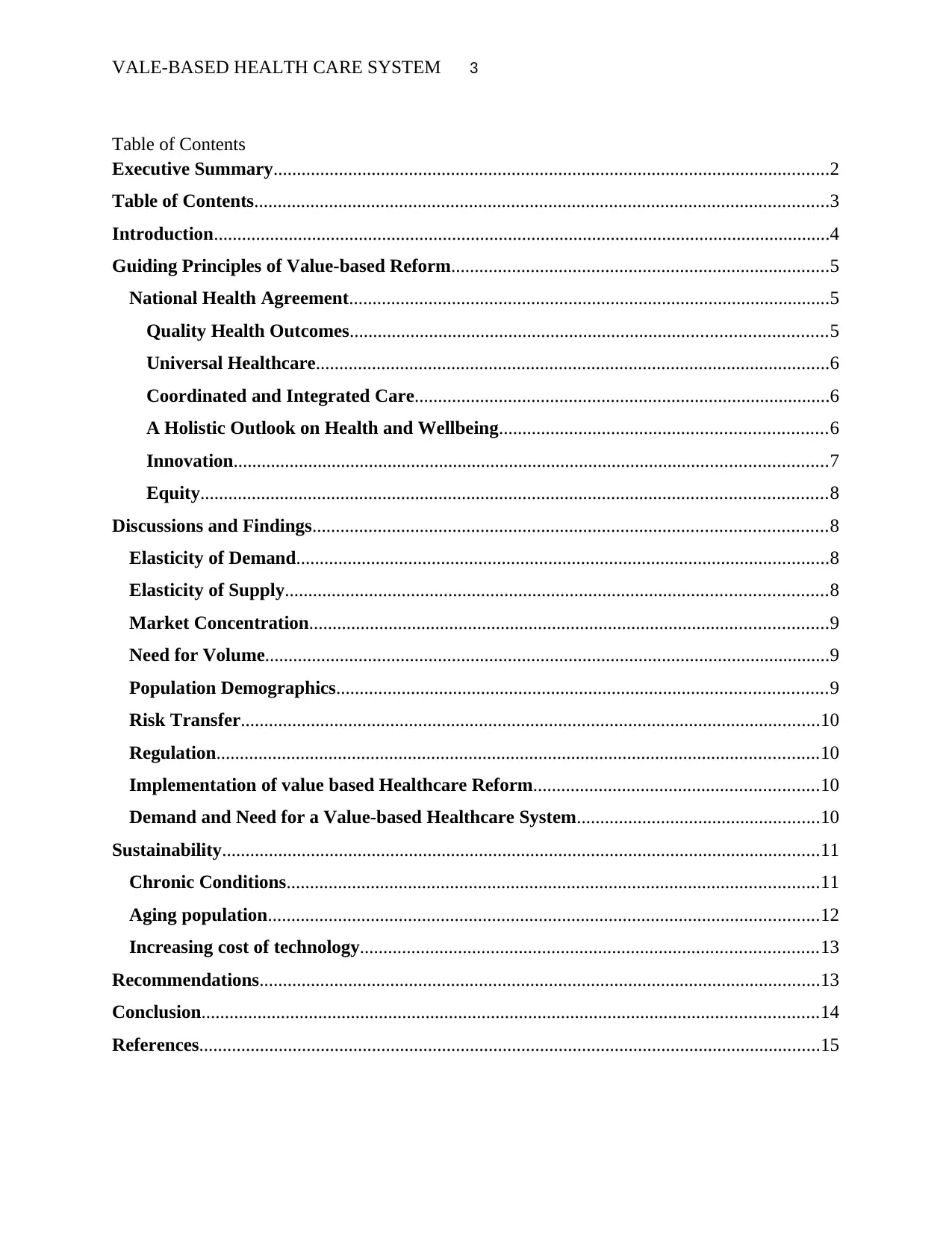
VALE-BASED HEALTH CARE SYSTEM 3
Table of Contents
Executive Summary.......................................................................................................................2
Table of Contents...........................................................................................................................3
Introduction....................................................................................................................................4
Guiding Principles of Value-based Reform.................................................................................5
National Health Agreement.......................................................................................................5
Quality Health Outcomes......................................................................................................5
Universal Healthcare..............................................................................................................6
Coordinated and Integrated Care.........................................................................................6
A Holistic Outlook on Health and Wellbeing......................................................................6
Innovation...............................................................................................................................7
Equity......................................................................................................................................8
Discussions and Findings..............................................................................................................8
Elasticity of Demand..................................................................................................................8
Elasticity of Supply....................................................................................................................8
Market Concentration...............................................................................................................9
Need for Volume.........................................................................................................................9
Population Demographics.........................................................................................................9
Risk Transfer............................................................................................................................10
Regulation.................................................................................................................................10
Implementation of value based Healthcare Reform.............................................................10
Demand and Need for a Value-based Healthcare System....................................................10
Sustainability................................................................................................................................11
Chronic Conditions..................................................................................................................11
Aging population......................................................................................................................12
Increasing cost of technology..................................................................................................13
Recommendations........................................................................................................................13
Conclusion....................................................................................................................................14
References.....................................................................................................................................15
Table of Contents
Executive Summary.......................................................................................................................2
Table of Contents...........................................................................................................................3
Introduction....................................................................................................................................4
Guiding Principles of Value-based Reform.................................................................................5
National Health Agreement.......................................................................................................5
Quality Health Outcomes......................................................................................................5
Universal Healthcare..............................................................................................................6
Coordinated and Integrated Care.........................................................................................6
A Holistic Outlook on Health and Wellbeing......................................................................6
Innovation...............................................................................................................................7
Equity......................................................................................................................................8
Discussions and Findings..............................................................................................................8
Elasticity of Demand..................................................................................................................8
Elasticity of Supply....................................................................................................................8
Market Concentration...............................................................................................................9
Need for Volume.........................................................................................................................9
Population Demographics.........................................................................................................9
Risk Transfer............................................................................................................................10
Regulation.................................................................................................................................10
Implementation of value based Healthcare Reform.............................................................10
Demand and Need for a Value-based Healthcare System....................................................10
Sustainability................................................................................................................................11
Chronic Conditions..................................................................................................................11
Aging population......................................................................................................................12
Increasing cost of technology..................................................................................................13
Recommendations........................................................................................................................13
Conclusion....................................................................................................................................14
References.....................................................................................................................................15
⊘ This is a preview!⊘
Do you want full access?
Subscribe today to unlock all pages.

Trusted by 1+ million students worldwide
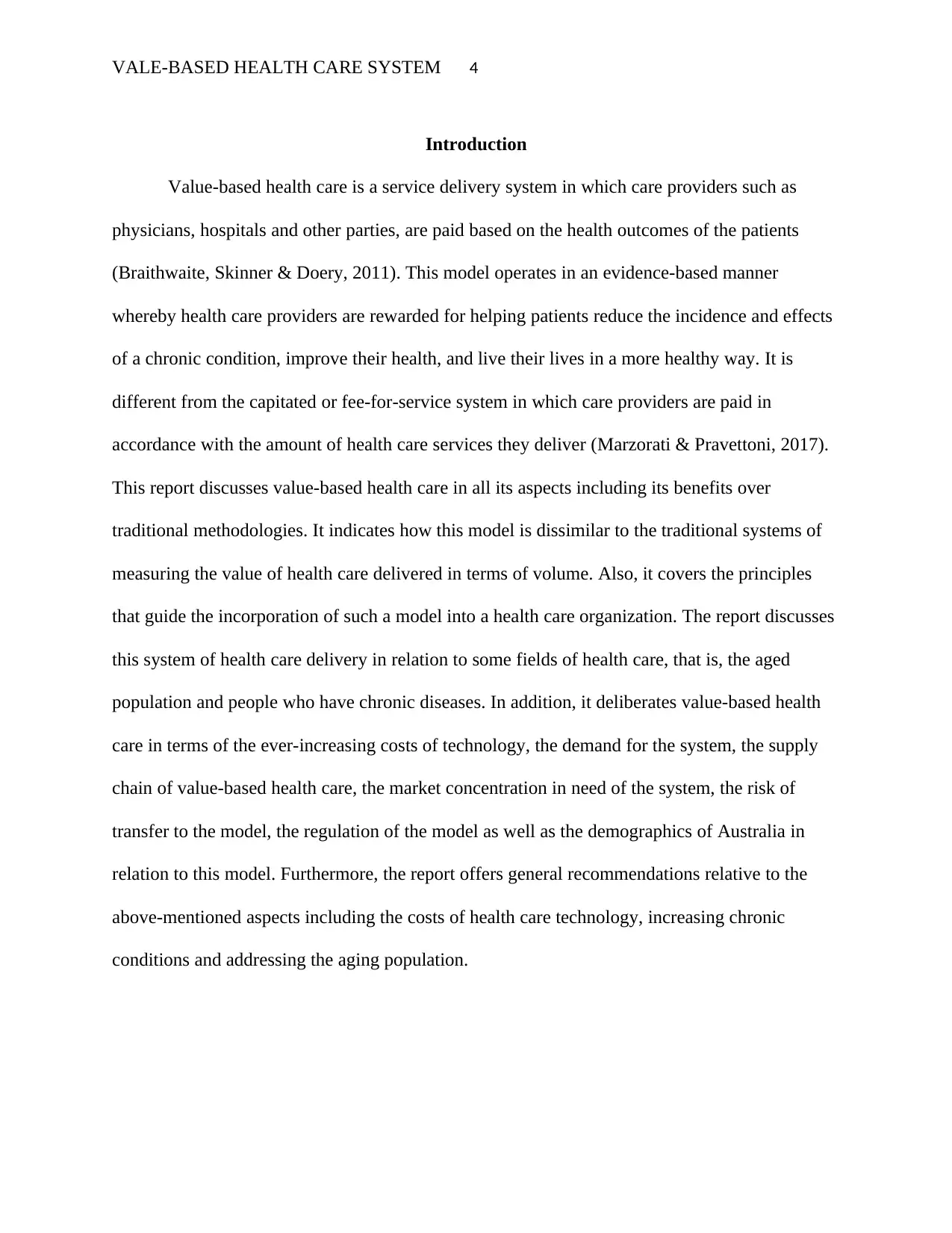
VALE-BASED HEALTH CARE SYSTEM 4
Introduction
Value-based health care is a service delivery system in which care providers such as
physicians, hospitals and other parties, are paid based on the health outcomes of the patients
(Braithwaite, Skinner & Doery, 2011). This model operates in an evidence-based manner
whereby health care providers are rewarded for helping patients reduce the incidence and effects
of a chronic condition, improve their health, and live their lives in a more healthy way. It is
different from the capitated or fee-for-service system in which care providers are paid in
accordance with the amount of health care services they deliver (Marzorati & Pravettoni, 2017).
This report discusses value-based health care in all its aspects including its benefits over
traditional methodologies. It indicates how this model is dissimilar to the traditional systems of
measuring the value of health care delivered in terms of volume. Also, it covers the principles
that guide the incorporation of such a model into a health care organization. The report discusses
this system of health care delivery in relation to some fields of health care, that is, the aged
population and people who have chronic diseases. In addition, it deliberates value-based health
care in terms of the ever-increasing costs of technology, the demand for the system, the supply
chain of value-based health care, the market concentration in need of the system, the risk of
transfer to the model, the regulation of the model as well as the demographics of Australia in
relation to this model. Furthermore, the report offers general recommendations relative to the
above-mentioned aspects including the costs of health care technology, increasing chronic
conditions and addressing the aging population.
Introduction
Value-based health care is a service delivery system in which care providers such as
physicians, hospitals and other parties, are paid based on the health outcomes of the patients
(Braithwaite, Skinner & Doery, 2011). This model operates in an evidence-based manner
whereby health care providers are rewarded for helping patients reduce the incidence and effects
of a chronic condition, improve their health, and live their lives in a more healthy way. It is
different from the capitated or fee-for-service system in which care providers are paid in
accordance with the amount of health care services they deliver (Marzorati & Pravettoni, 2017).
This report discusses value-based health care in all its aspects including its benefits over
traditional methodologies. It indicates how this model is dissimilar to the traditional systems of
measuring the value of health care delivered in terms of volume. Also, it covers the principles
that guide the incorporation of such a model into a health care organization. The report discusses
this system of health care delivery in relation to some fields of health care, that is, the aged
population and people who have chronic diseases. In addition, it deliberates value-based health
care in terms of the ever-increasing costs of technology, the demand for the system, the supply
chain of value-based health care, the market concentration in need of the system, the risk of
transfer to the model, the regulation of the model as well as the demographics of Australia in
relation to this model. Furthermore, the report offers general recommendations relative to the
above-mentioned aspects including the costs of health care technology, increasing chronic
conditions and addressing the aging population.
Paraphrase This Document
Need a fresh take? Get an instant paraphrase of this document with our AI Paraphraser
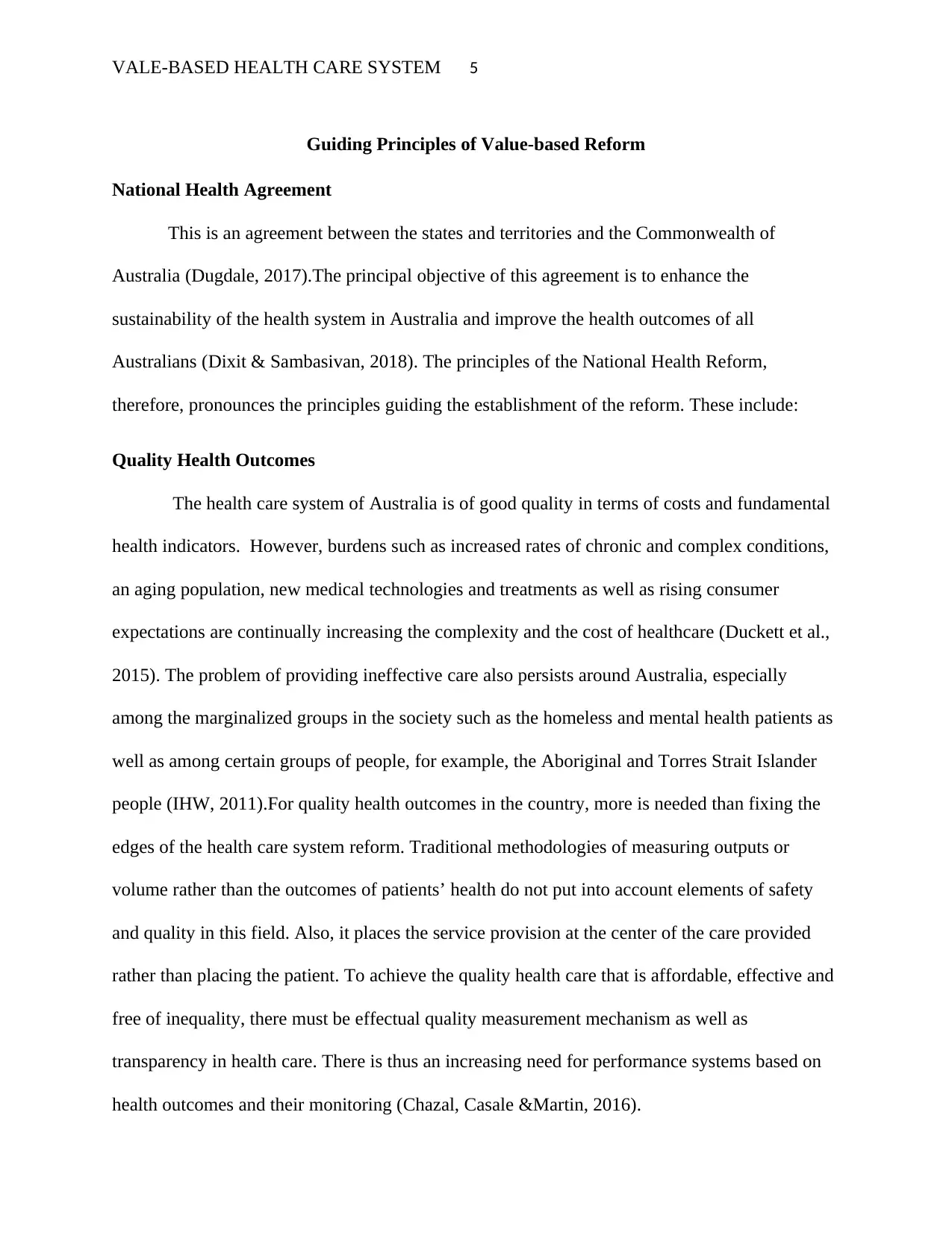
VALE-BASED HEALTH CARE SYSTEM 5
Guiding Principles of Value-based Reform
National Health Agreement
This is an agreement between the states and territories and the Commonwealth of
Australia (Dugdale, 2017).The principal objective of this agreement is to enhance the
sustainability of the health system in Australia and improve the health outcomes of all
Australians (Dixit & Sambasivan, 2018). The principles of the National Health Reform,
therefore, pronounces the principles guiding the establishment of the reform. These include:
Quality Health Outcomes
The health care system of Australia is of good quality in terms of costs and fundamental
health indicators. However, burdens such as increased rates of chronic and complex conditions,
an aging population, new medical technologies and treatments as well as rising consumer
expectations are continually increasing the complexity and the cost of healthcare (Duckett et al.,
2015). The problem of providing ineffective care also persists around Australia, especially
among the marginalized groups in the society such as the homeless and mental health patients as
well as among certain groups of people, for example, the Aboriginal and Torres Strait Islander
people (IHW, 2011).For quality health outcomes in the country, more is needed than fixing the
edges of the health care system reform. Traditional methodologies of measuring outputs or
volume rather than the outcomes of patients’ health do not put into account elements of safety
and quality in this field. Also, it places the service provision at the center of the care provided
rather than placing the patient. To achieve the quality health care that is affordable, effective and
free of inequality, there must be effectual quality measurement mechanism as well as
transparency in health care. There is thus an increasing need for performance systems based on
health outcomes and their monitoring (Chazal, Casale &Martin, 2016).
Guiding Principles of Value-based Reform
National Health Agreement
This is an agreement between the states and territories and the Commonwealth of
Australia (Dugdale, 2017).The principal objective of this agreement is to enhance the
sustainability of the health system in Australia and improve the health outcomes of all
Australians (Dixit & Sambasivan, 2018). The principles of the National Health Reform,
therefore, pronounces the principles guiding the establishment of the reform. These include:
Quality Health Outcomes
The health care system of Australia is of good quality in terms of costs and fundamental
health indicators. However, burdens such as increased rates of chronic and complex conditions,
an aging population, new medical technologies and treatments as well as rising consumer
expectations are continually increasing the complexity and the cost of healthcare (Duckett et al.,
2015). The problem of providing ineffective care also persists around Australia, especially
among the marginalized groups in the society such as the homeless and mental health patients as
well as among certain groups of people, for example, the Aboriginal and Torres Strait Islander
people (IHW, 2011).For quality health outcomes in the country, more is needed than fixing the
edges of the health care system reform. Traditional methodologies of measuring outputs or
volume rather than the outcomes of patients’ health do not put into account elements of safety
and quality in this field. Also, it places the service provision at the center of the care provided
rather than placing the patient. To achieve the quality health care that is affordable, effective and
free of inequality, there must be effectual quality measurement mechanism as well as
transparency in health care. There is thus an increasing need for performance systems based on
health outcomes and their monitoring (Chazal, Casale &Martin, 2016).
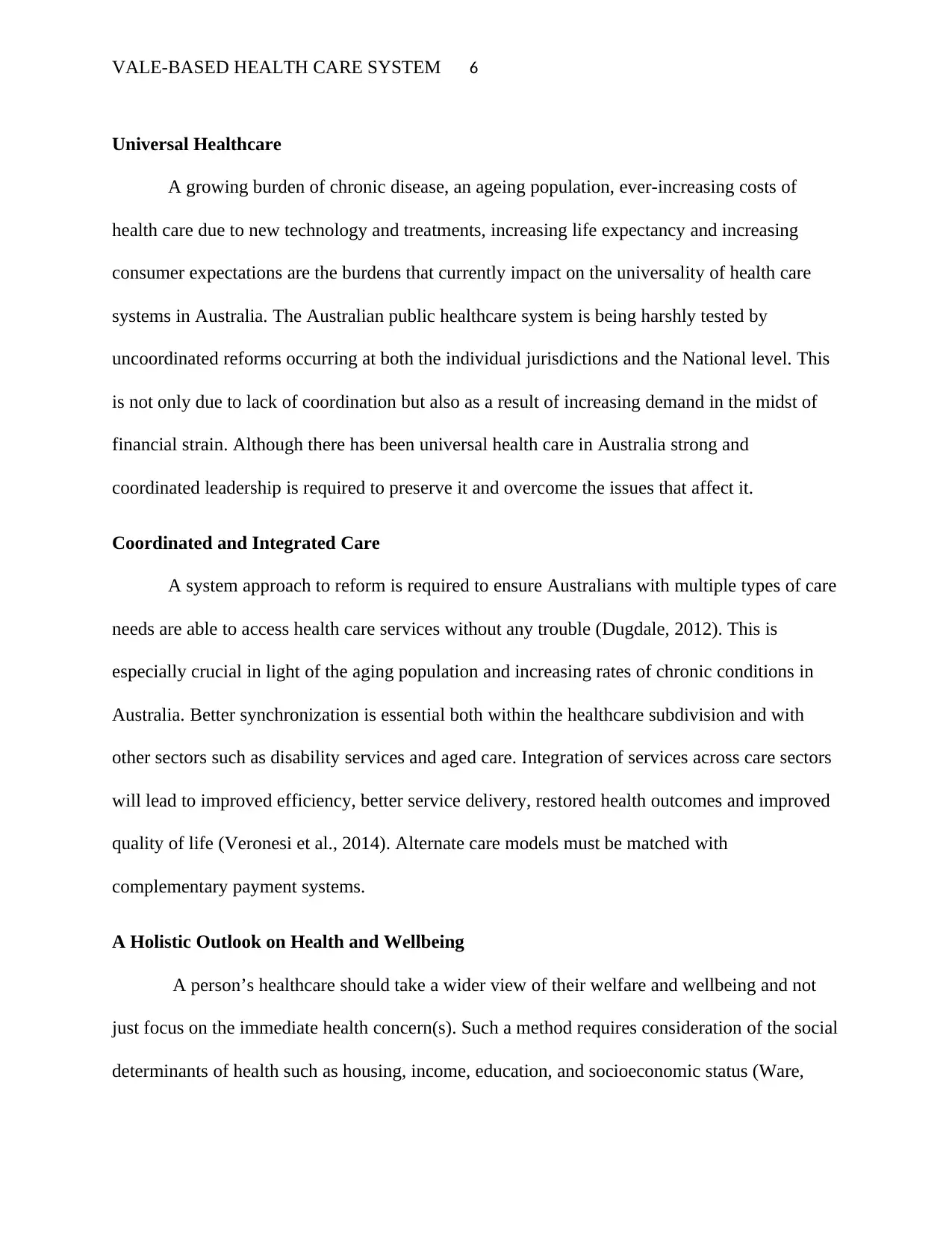
VALE-BASED HEALTH CARE SYSTEM 6
Universal Healthcare
A growing burden of chronic disease, an ageing population, ever-increasing costs of
health care due to new technology and treatments, increasing life expectancy and increasing
consumer expectations are the burdens that currently impact on the universality of health care
systems in Australia. The Australian public healthcare system is being harshly tested by
uncoordinated reforms occurring at both the individual jurisdictions and the National level. This
is not only due to lack of coordination but also as a result of increasing demand in the midst of
financial strain. Although there has been universal health care in Australia strong and
coordinated leadership is required to preserve it and overcome the issues that affect it.
Coordinated and Integrated Care
A system approach to reform is required to ensure Australians with multiple types of care
needs are able to access health care services without any trouble (Dugdale, 2012). This is
especially crucial in light of the aging population and increasing rates of chronic conditions in
Australia. Better synchronization is essential both within the healthcare subdivision and with
other sectors such as disability services and aged care. Integration of services across care sectors
will lead to improved efficiency, better service delivery, restored health outcomes and improved
quality of life (Veronesi et al., 2014). Alternate care models must be matched with
complementary payment systems.
A Holistic Outlook on Health and Wellbeing
A person’s healthcare should take a wider view of their welfare and wellbeing and not
just focus on the immediate health concern(s). Such a method requires consideration of the social
determinants of health such as housing, income, education, and socioeconomic status (Ware,
Universal Healthcare
A growing burden of chronic disease, an ageing population, ever-increasing costs of
health care due to new technology and treatments, increasing life expectancy and increasing
consumer expectations are the burdens that currently impact on the universality of health care
systems in Australia. The Australian public healthcare system is being harshly tested by
uncoordinated reforms occurring at both the individual jurisdictions and the National level. This
is not only due to lack of coordination but also as a result of increasing demand in the midst of
financial strain. Although there has been universal health care in Australia strong and
coordinated leadership is required to preserve it and overcome the issues that affect it.
Coordinated and Integrated Care
A system approach to reform is required to ensure Australians with multiple types of care
needs are able to access health care services without any trouble (Dugdale, 2012). This is
especially crucial in light of the aging population and increasing rates of chronic conditions in
Australia. Better synchronization is essential both within the healthcare subdivision and with
other sectors such as disability services and aged care. Integration of services across care sectors
will lead to improved efficiency, better service delivery, restored health outcomes and improved
quality of life (Veronesi et al., 2014). Alternate care models must be matched with
complementary payment systems.
A Holistic Outlook on Health and Wellbeing
A person’s healthcare should take a wider view of their welfare and wellbeing and not
just focus on the immediate health concern(s). Such a method requires consideration of the social
determinants of health such as housing, income, education, and socioeconomic status (Ware,
⊘ This is a preview!⊘
Do you want full access?
Subscribe today to unlock all pages.

Trusted by 1+ million students worldwide
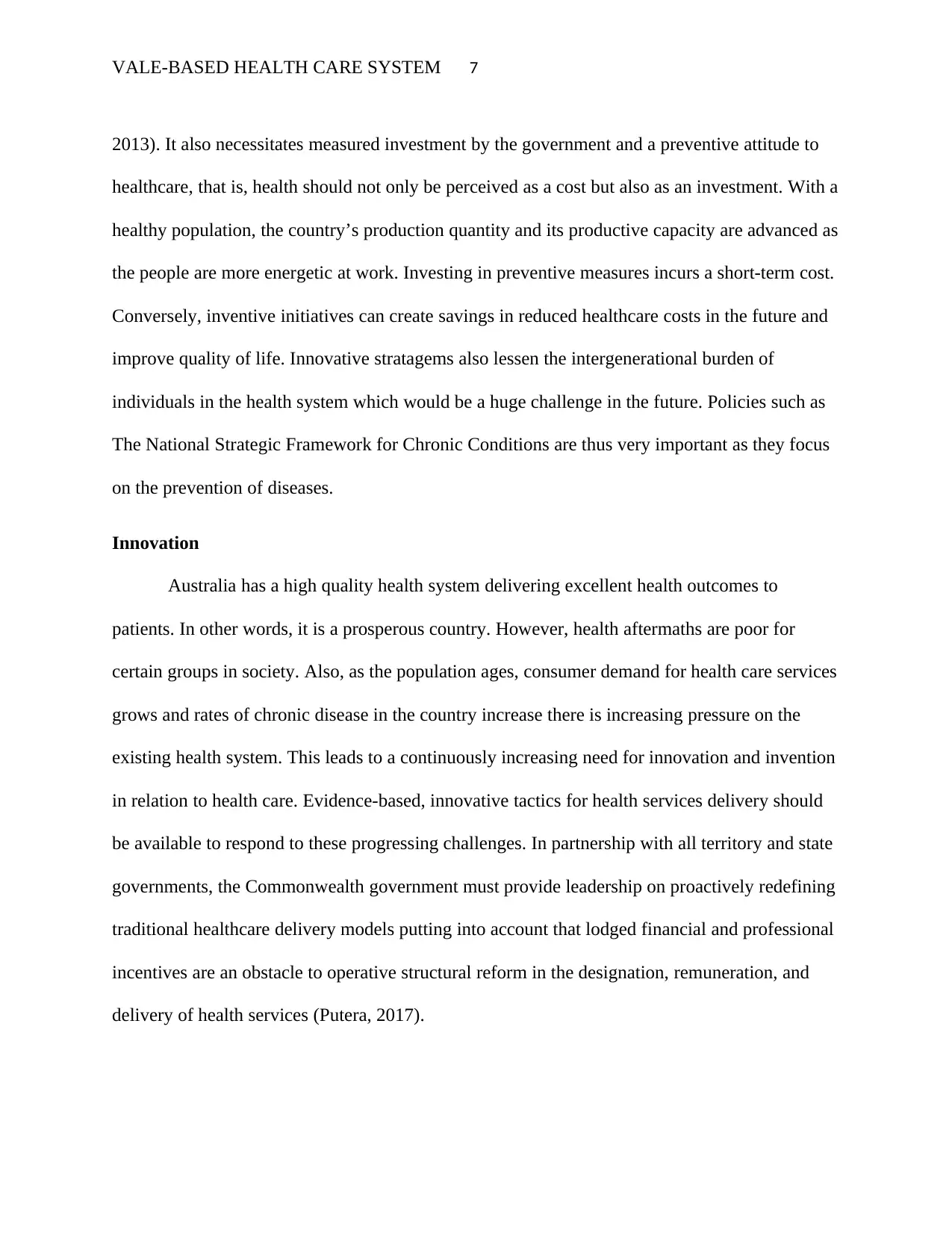
VALE-BASED HEALTH CARE SYSTEM 7
2013). It also necessitates measured investment by the government and a preventive attitude to
healthcare, that is, health should not only be perceived as a cost but also as an investment. With a
healthy population, the country’s production quantity and its productive capacity are advanced as
the people are more energetic at work. Investing in preventive measures incurs a short-term cost.
Conversely, inventive initiatives can create savings in reduced healthcare costs in the future and
improve quality of life. Innovative stratagems also lessen the intergenerational burden of
individuals in the health system which would be a huge challenge in the future. Policies such as
The National Strategic Framework for Chronic Conditions are thus very important as they focus
on the prevention of diseases.
Innovation
Australia has a high quality health system delivering excellent health outcomes to
patients. In other words, it is a prosperous country. However, health aftermaths are poor for
certain groups in society. Also, as the population ages, consumer demand for health care services
grows and rates of chronic disease in the country increase there is increasing pressure on the
existing health system. This leads to a continuously increasing need for innovation and invention
in relation to health care. Evidence-based, innovative tactics for health services delivery should
be available to respond to these progressing challenges. In partnership with all territory and state
governments, the Commonwealth government must provide leadership on proactively redefining
traditional healthcare delivery models putting into account that lodged financial and professional
incentives are an obstacle to operative structural reform in the designation, remuneration, and
delivery of health services (Putera, 2017).
2013). It also necessitates measured investment by the government and a preventive attitude to
healthcare, that is, health should not only be perceived as a cost but also as an investment. With a
healthy population, the country’s production quantity and its productive capacity are advanced as
the people are more energetic at work. Investing in preventive measures incurs a short-term cost.
Conversely, inventive initiatives can create savings in reduced healthcare costs in the future and
improve quality of life. Innovative stratagems also lessen the intergenerational burden of
individuals in the health system which would be a huge challenge in the future. Policies such as
The National Strategic Framework for Chronic Conditions are thus very important as they focus
on the prevention of diseases.
Innovation
Australia has a high quality health system delivering excellent health outcomes to
patients. In other words, it is a prosperous country. However, health aftermaths are poor for
certain groups in society. Also, as the population ages, consumer demand for health care services
grows and rates of chronic disease in the country increase there is increasing pressure on the
existing health system. This leads to a continuously increasing need for innovation and invention
in relation to health care. Evidence-based, innovative tactics for health services delivery should
be available to respond to these progressing challenges. In partnership with all territory and state
governments, the Commonwealth government must provide leadership on proactively redefining
traditional healthcare delivery models putting into account that lodged financial and professional
incentives are an obstacle to operative structural reform in the designation, remuneration, and
delivery of health services (Putera, 2017).
Paraphrase This Document
Need a fresh take? Get an instant paraphrase of this document with our AI Paraphraser
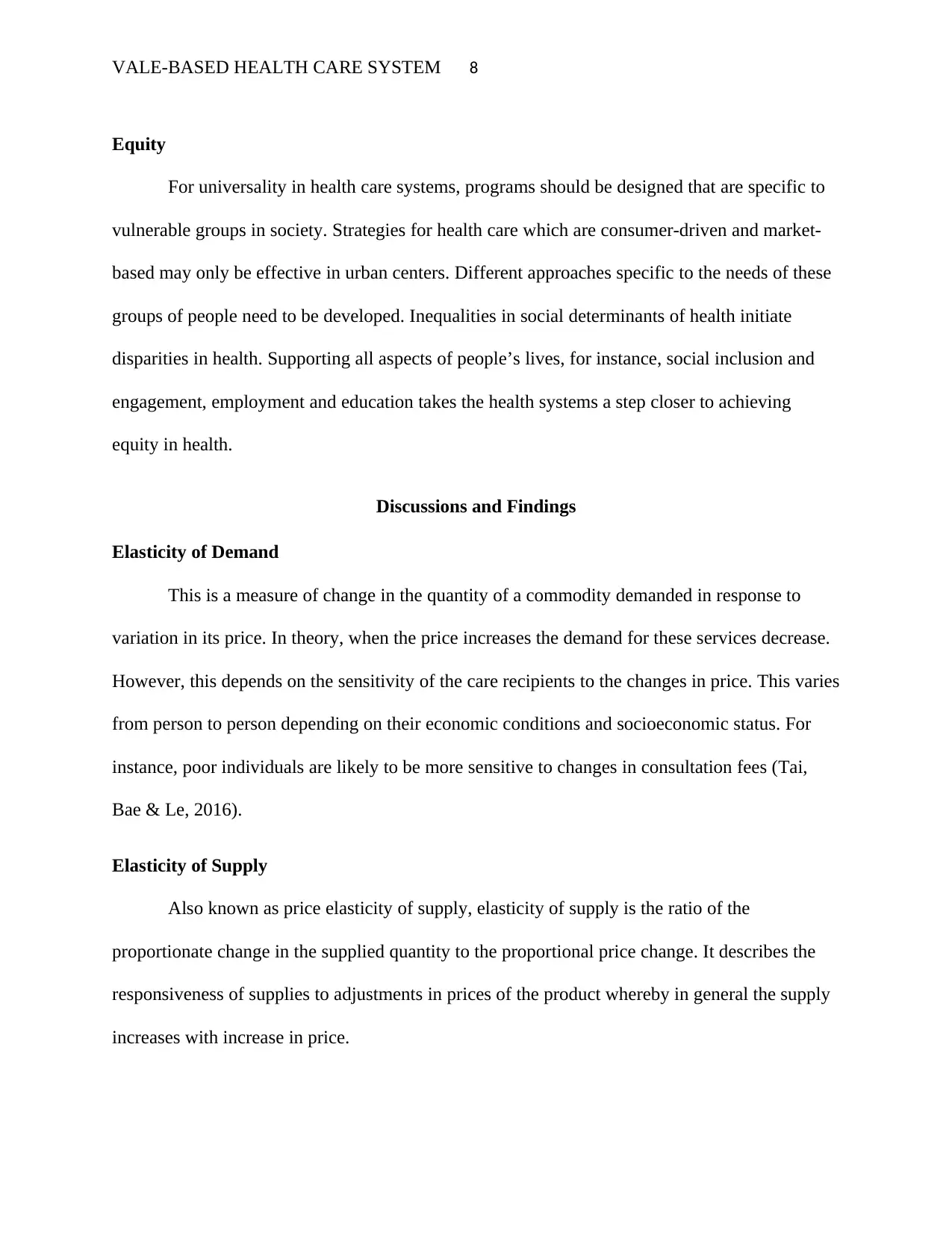
VALE-BASED HEALTH CARE SYSTEM 8
Equity
For universality in health care systems, programs should be designed that are specific to
vulnerable groups in society. Strategies for health care which are consumer-driven and market-
based may only be effective in urban centers. Different approaches specific to the needs of these
groups of people need to be developed. Inequalities in social determinants of health initiate
disparities in health. Supporting all aspects of people’s lives, for instance, social inclusion and
engagement, employment and education takes the health systems a step closer to achieving
equity in health.
Discussions and Findings
Elasticity of Demand
This is a measure of change in the quantity of a commodity demanded in response to
variation in its price. In theory, when the price increases the demand for these services decrease.
However, this depends on the sensitivity of the care recipients to the changes in price. This varies
from person to person depending on their economic conditions and socioeconomic status. For
instance, poor individuals are likely to be more sensitive to changes in consultation fees (Tai,
Bae & Le, 2016).
Elasticity of Supply
Also known as price elasticity of supply, elasticity of supply is the ratio of the
proportionate change in the supplied quantity to the proportional price change. It describes the
responsiveness of supplies to adjustments in prices of the product whereby in general the supply
increases with increase in price.
Equity
For universality in health care systems, programs should be designed that are specific to
vulnerable groups in society. Strategies for health care which are consumer-driven and market-
based may only be effective in urban centers. Different approaches specific to the needs of these
groups of people need to be developed. Inequalities in social determinants of health initiate
disparities in health. Supporting all aspects of people’s lives, for instance, social inclusion and
engagement, employment and education takes the health systems a step closer to achieving
equity in health.
Discussions and Findings
Elasticity of Demand
This is a measure of change in the quantity of a commodity demanded in response to
variation in its price. In theory, when the price increases the demand for these services decrease.
However, this depends on the sensitivity of the care recipients to the changes in price. This varies
from person to person depending on their economic conditions and socioeconomic status. For
instance, poor individuals are likely to be more sensitive to changes in consultation fees (Tai,
Bae & Le, 2016).
Elasticity of Supply
Also known as price elasticity of supply, elasticity of supply is the ratio of the
proportionate change in the supplied quantity to the proportional price change. It describes the
responsiveness of supplies to adjustments in prices of the product whereby in general the supply
increases with increase in price.
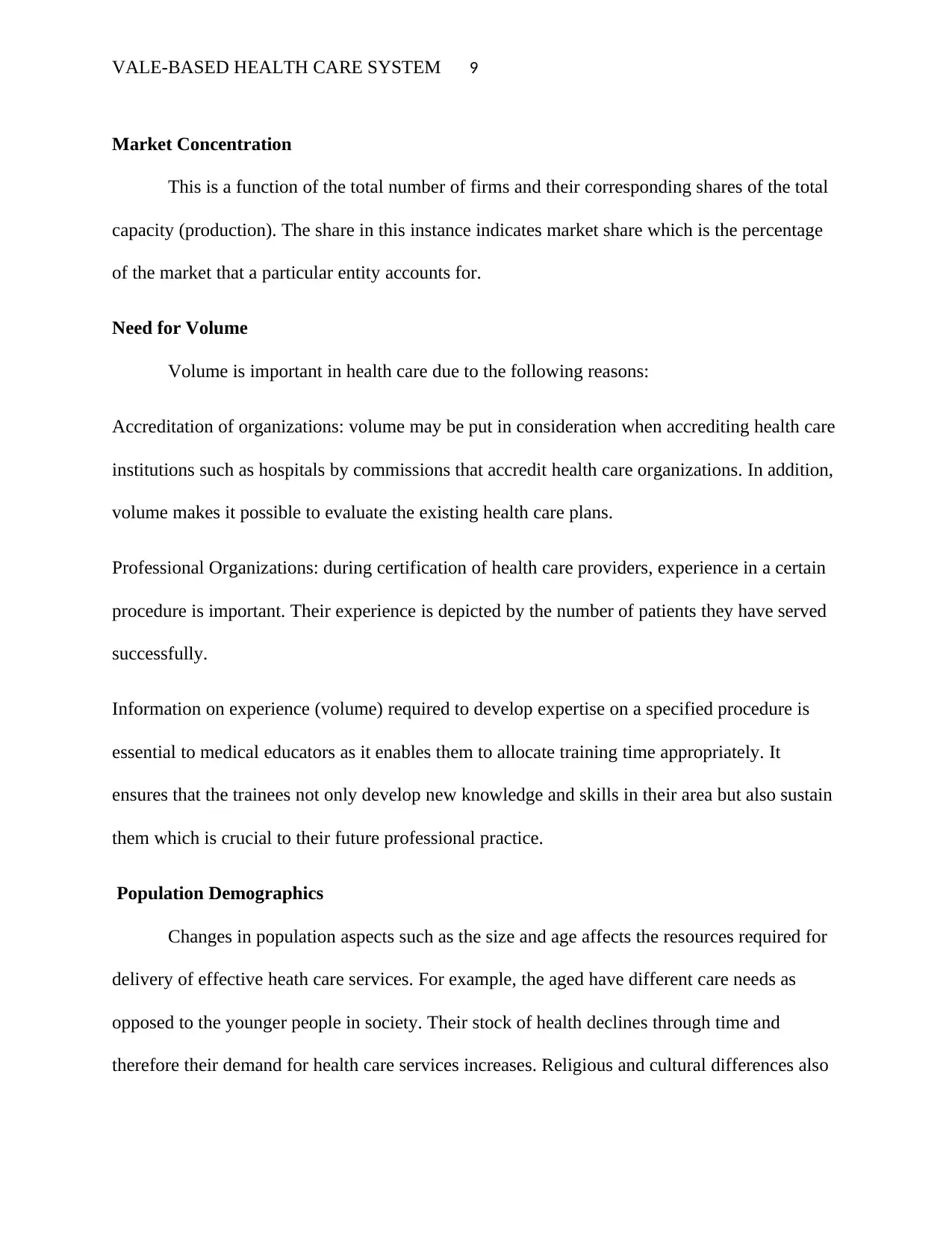
VALE-BASED HEALTH CARE SYSTEM 9
Market Concentration
This is a function of the total number of firms and their corresponding shares of the total
capacity (production). The share in this instance indicates market share which is the percentage
of the market that a particular entity accounts for.
Need for Volume
Volume is important in health care due to the following reasons:
Accreditation of organizations: volume may be put in consideration when accrediting health care
institutions such as hospitals by commissions that accredit health care organizations. In addition,
volume makes it possible to evaluate the existing health care plans.
Professional Organizations: during certification of health care providers, experience in a certain
procedure is important. Their experience is depicted by the number of patients they have served
successfully.
Information on experience (volume) required to develop expertise on a specified procedure is
essential to medical educators as it enables them to allocate training time appropriately. It
ensures that the trainees not only develop new knowledge and skills in their area but also sustain
them which is crucial to their future professional practice.
Population Demographics
Changes in population aspects such as the size and age affects the resources required for
delivery of effective heath care services. For example, the aged have different care needs as
opposed to the younger people in society. Their stock of health declines through time and
therefore their demand for health care services increases. Religious and cultural differences also
Market Concentration
This is a function of the total number of firms and their corresponding shares of the total
capacity (production). The share in this instance indicates market share which is the percentage
of the market that a particular entity accounts for.
Need for Volume
Volume is important in health care due to the following reasons:
Accreditation of organizations: volume may be put in consideration when accrediting health care
institutions such as hospitals by commissions that accredit health care organizations. In addition,
volume makes it possible to evaluate the existing health care plans.
Professional Organizations: during certification of health care providers, experience in a certain
procedure is important. Their experience is depicted by the number of patients they have served
successfully.
Information on experience (volume) required to develop expertise on a specified procedure is
essential to medical educators as it enables them to allocate training time appropriately. It
ensures that the trainees not only develop new knowledge and skills in their area but also sustain
them which is crucial to their future professional practice.
Population Demographics
Changes in population aspects such as the size and age affects the resources required for
delivery of effective heath care services. For example, the aged have different care needs as
opposed to the younger people in society. Their stock of health declines through time and
therefore their demand for health care services increases. Religious and cultural differences also
⊘ This is a preview!⊘
Do you want full access?
Subscribe today to unlock all pages.

Trusted by 1+ million students worldwide
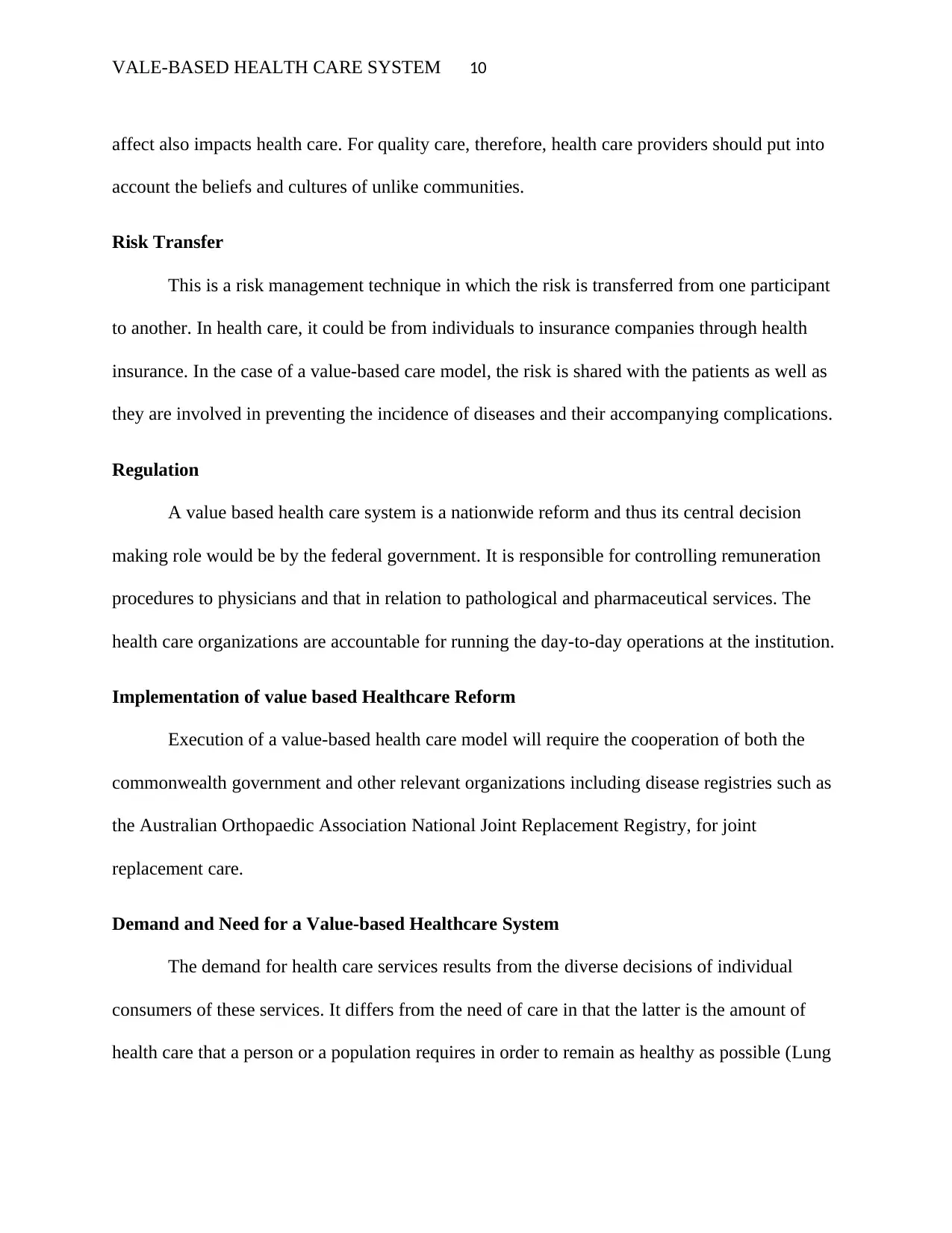
VALE-BASED HEALTH CARE SYSTEM 10
affect also impacts health care. For quality care, therefore, health care providers should put into
account the beliefs and cultures of unlike communities.
Risk Transfer
This is a risk management technique in which the risk is transferred from one participant
to another. In health care, it could be from individuals to insurance companies through health
insurance. In the case of a value-based care model, the risk is shared with the patients as well as
they are involved in preventing the incidence of diseases and their accompanying complications.
Regulation
A value based health care system is a nationwide reform and thus its central decision
making role would be by the federal government. It is responsible for controlling remuneration
procedures to physicians and that in relation to pathological and pharmaceutical services. The
health care organizations are accountable for running the day-to-day operations at the institution.
Implementation of value based Healthcare Reform
Execution of a value-based health care model will require the cooperation of both the
commonwealth government and other relevant organizations including disease registries such as
the Australian Orthopaedic Association National Joint Replacement Registry, for joint
replacement care.
Demand and Need for a Value-based Healthcare System
The demand for health care services results from the diverse decisions of individual
consumers of these services. It differs from the need of care in that the latter is the amount of
health care that a person or a population requires in order to remain as healthy as possible (Lung
affect also impacts health care. For quality care, therefore, health care providers should put into
account the beliefs and cultures of unlike communities.
Risk Transfer
This is a risk management technique in which the risk is transferred from one participant
to another. In health care, it could be from individuals to insurance companies through health
insurance. In the case of a value-based care model, the risk is shared with the patients as well as
they are involved in preventing the incidence of diseases and their accompanying complications.
Regulation
A value based health care system is a nationwide reform and thus its central decision
making role would be by the federal government. It is responsible for controlling remuneration
procedures to physicians and that in relation to pathological and pharmaceutical services. The
health care organizations are accountable for running the day-to-day operations at the institution.
Implementation of value based Healthcare Reform
Execution of a value-based health care model will require the cooperation of both the
commonwealth government and other relevant organizations including disease registries such as
the Australian Orthopaedic Association National Joint Replacement Registry, for joint
replacement care.
Demand and Need for a Value-based Healthcare System
The demand for health care services results from the diverse decisions of individual
consumers of these services. It differs from the need of care in that the latter is the amount of
health care that a person or a population requires in order to remain as healthy as possible (Lung
Paraphrase This Document
Need a fresh take? Get an instant paraphrase of this document with our AI Paraphraser
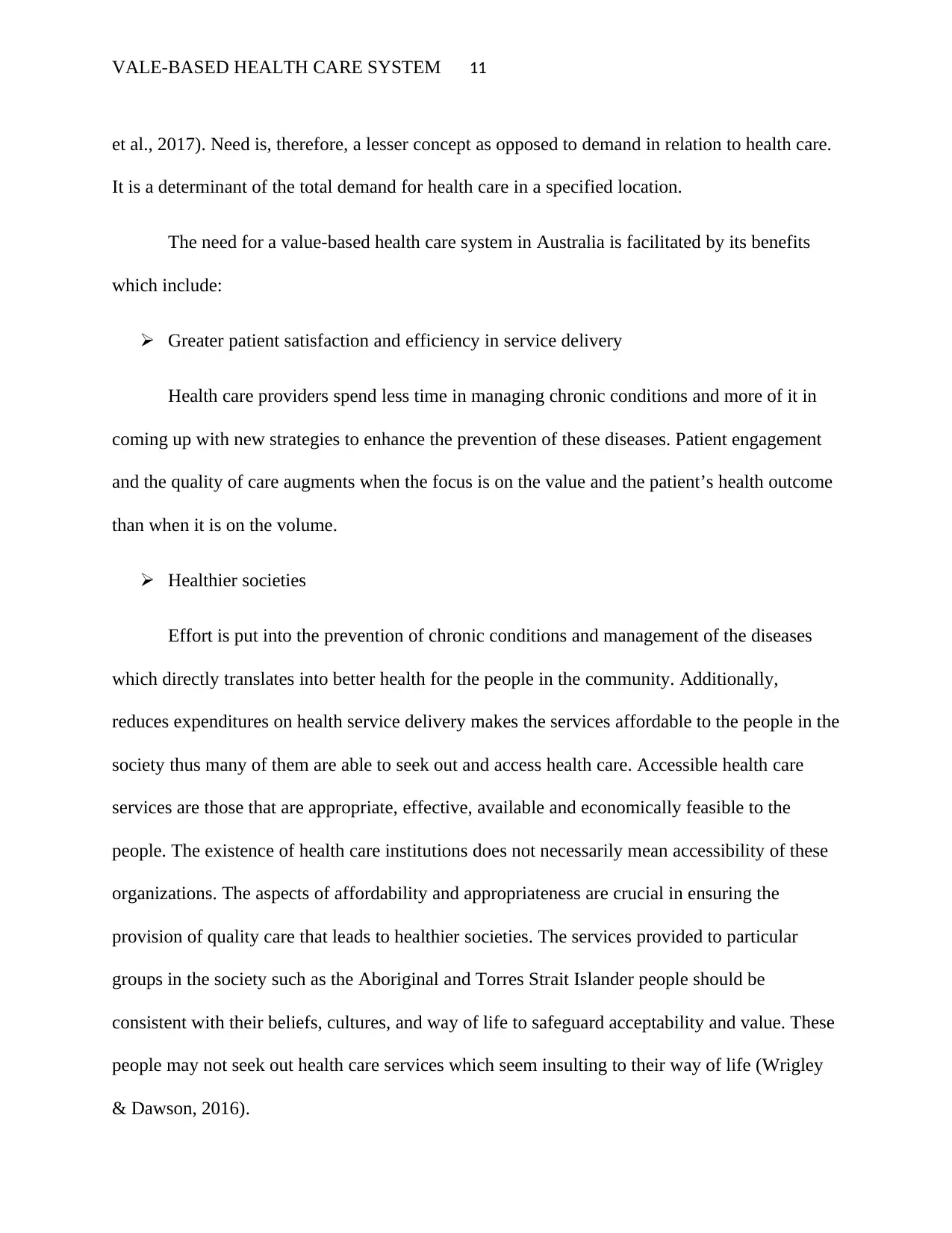
VALE-BASED HEALTH CARE SYSTEM 11
et al., 2017). Need is, therefore, a lesser concept as opposed to demand in relation to health care.
It is a determinant of the total demand for health care in a specified location.
The need for a value-based health care system in Australia is facilitated by its benefits
which include:
Greater patient satisfaction and efficiency in service delivery
Health care providers spend less time in managing chronic conditions and more of it in
coming up with new strategies to enhance the prevention of these diseases. Patient engagement
and the quality of care augments when the focus is on the value and the patient’s health outcome
than when it is on the volume.
Healthier societies
Effort is put into the prevention of chronic conditions and management of the diseases
which directly translates into better health for the people in the community. Additionally,
reduces expenditures on health service delivery makes the services affordable to the people in the
society thus many of them are able to seek out and access health care. Accessible health care
services are those that are appropriate, effective, available and economically feasible to the
people. The existence of health care institutions does not necessarily mean accessibility of these
organizations. The aspects of affordability and appropriateness are crucial in ensuring the
provision of quality care that leads to healthier societies. The services provided to particular
groups in the society such as the Aboriginal and Torres Strait Islander people should be
consistent with their beliefs, cultures, and way of life to safeguard acceptability and value. These
people may not seek out health care services which seem insulting to their way of life (Wrigley
& Dawson, 2016).
et al., 2017). Need is, therefore, a lesser concept as opposed to demand in relation to health care.
It is a determinant of the total demand for health care in a specified location.
The need for a value-based health care system in Australia is facilitated by its benefits
which include:
Greater patient satisfaction and efficiency in service delivery
Health care providers spend less time in managing chronic conditions and more of it in
coming up with new strategies to enhance the prevention of these diseases. Patient engagement
and the quality of care augments when the focus is on the value and the patient’s health outcome
than when it is on the volume.
Healthier societies
Effort is put into the prevention of chronic conditions and management of the diseases
which directly translates into better health for the people in the community. Additionally,
reduces expenditures on health service delivery makes the services affordable to the people in the
society thus many of them are able to seek out and access health care. Accessible health care
services are those that are appropriate, effective, available and economically feasible to the
people. The existence of health care institutions does not necessarily mean accessibility of these
organizations. The aspects of affordability and appropriateness are crucial in ensuring the
provision of quality care that leads to healthier societies. The services provided to particular
groups in the society such as the Aboriginal and Torres Strait Islander people should be
consistent with their beliefs, cultures, and way of life to safeguard acceptability and value. These
people may not seek out health care services which seem insulting to their way of life (Wrigley
& Dawson, 2016).
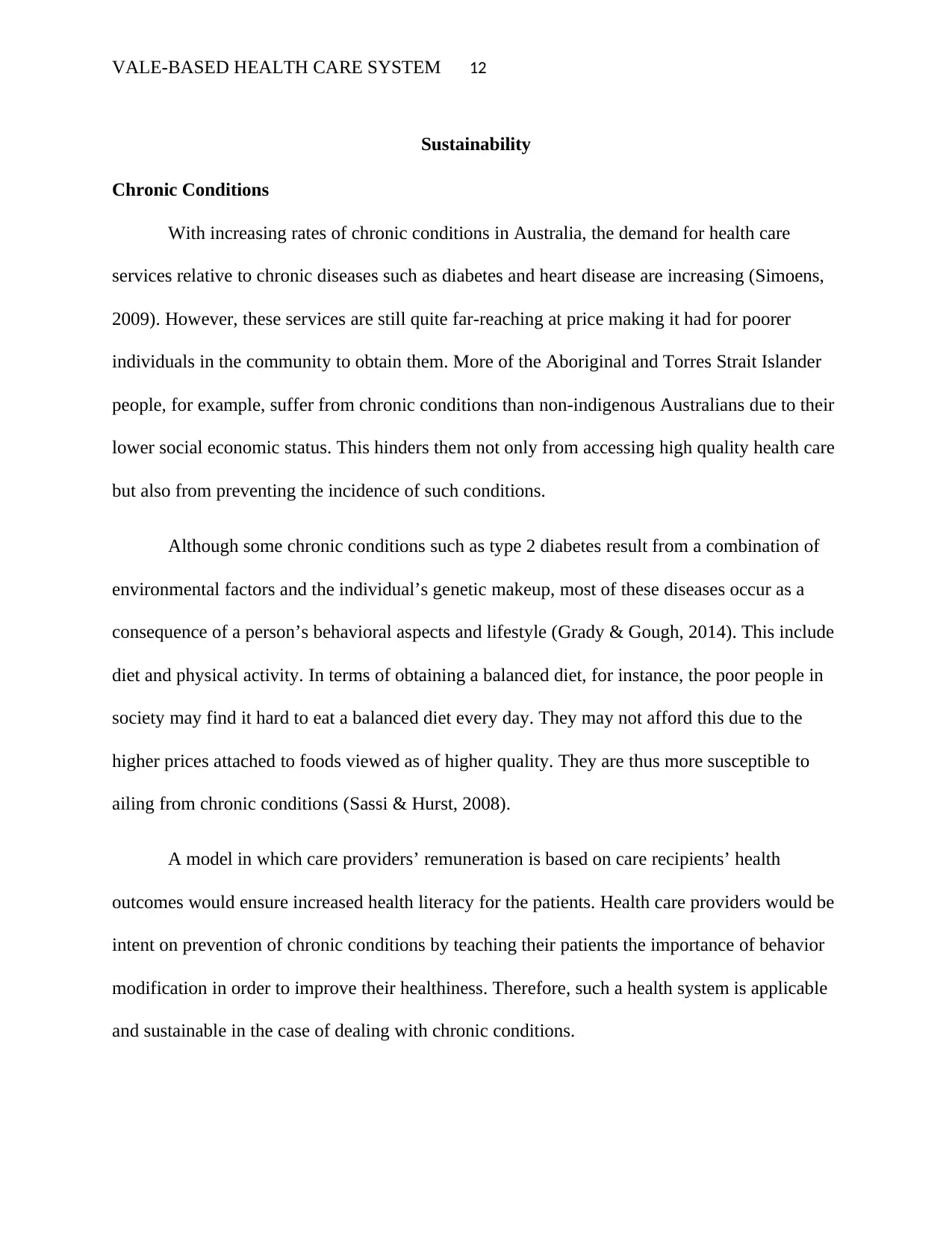
VALE-BASED HEALTH CARE SYSTEM 12
Sustainability
Chronic Conditions
With increasing rates of chronic conditions in Australia, the demand for health care
services relative to chronic diseases such as diabetes and heart disease are increasing (Simoens,
2009). However, these services are still quite far-reaching at price making it had for poorer
individuals in the community to obtain them. More of the Aboriginal and Torres Strait Islander
people, for example, suffer from chronic conditions than non-indigenous Australians due to their
lower social economic status. This hinders them not only from accessing high quality health care
but also from preventing the incidence of such conditions.
Although some chronic conditions such as type 2 diabetes result from a combination of
environmental factors and the individual’s genetic makeup, most of these diseases occur as a
consequence of a person’s behavioral aspects and lifestyle (Grady & Gough, 2014). This include
diet and physical activity. In terms of obtaining a balanced diet, for instance, the poor people in
society may find it hard to eat a balanced diet every day. They may not afford this due to the
higher prices attached to foods viewed as of higher quality. They are thus more susceptible to
ailing from chronic conditions (Sassi & Hurst, 2008).
A model in which care providers’ remuneration is based on care recipients’ health
outcomes would ensure increased health literacy for the patients. Health care providers would be
intent on prevention of chronic conditions by teaching their patients the importance of behavior
modification in order to improve their healthiness. Therefore, such a health system is applicable
and sustainable in the case of dealing with chronic conditions.
Sustainability
Chronic Conditions
With increasing rates of chronic conditions in Australia, the demand for health care
services relative to chronic diseases such as diabetes and heart disease are increasing (Simoens,
2009). However, these services are still quite far-reaching at price making it had for poorer
individuals in the community to obtain them. More of the Aboriginal and Torres Strait Islander
people, for example, suffer from chronic conditions than non-indigenous Australians due to their
lower social economic status. This hinders them not only from accessing high quality health care
but also from preventing the incidence of such conditions.
Although some chronic conditions such as type 2 diabetes result from a combination of
environmental factors and the individual’s genetic makeup, most of these diseases occur as a
consequence of a person’s behavioral aspects and lifestyle (Grady & Gough, 2014). This include
diet and physical activity. In terms of obtaining a balanced diet, for instance, the poor people in
society may find it hard to eat a balanced diet every day. They may not afford this due to the
higher prices attached to foods viewed as of higher quality. They are thus more susceptible to
ailing from chronic conditions (Sassi & Hurst, 2008).
A model in which care providers’ remuneration is based on care recipients’ health
outcomes would ensure increased health literacy for the patients. Health care providers would be
intent on prevention of chronic conditions by teaching their patients the importance of behavior
modification in order to improve their healthiness. Therefore, such a health system is applicable
and sustainable in the case of dealing with chronic conditions.
⊘ This is a preview!⊘
Do you want full access?
Subscribe today to unlock all pages.

Trusted by 1+ million students worldwide
1 out of 19
Related Documents
Your All-in-One AI-Powered Toolkit for Academic Success.
+13062052269
info@desklib.com
Available 24*7 on WhatsApp / Email
![[object Object]](/_next/static/media/star-bottom.7253800d.svg)
Unlock your academic potential
Copyright © 2020–2025 A2Z Services. All Rights Reserved. Developed and managed by ZUCOL.




